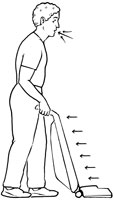Most of us take breathing for granted. We don’t have to think about it. It just happens. But people with chronic lung disease have to use coordinated breathing to conserve their energy. Coordinated breathing helps them stay active and handle day-to-day tasks without getting too short of breath.
Download How to Conserve Energy During Daily Life as a PDF.
If you have lung disease, you may often feel like you can’t get enough air into your lungs. So, you breathe faster. But that means you’re not emptying your lungs before your next breath. This is called “breath stacking,” and it makes you feel even more out of breath.
Let’s explore some techniques to help you avoid “breath stacking” and breathe more freely.
What parts of breathing can you control?
- Depth of the breath: Breathing with your diaphragm helps get air into the lower part of your lungs. That allows the lower part of your lungs to also exchange oxygen for carbon dioxide and other gases.
- Pace of breath: You can control how fast you breathe. If you pant or take short, shallow breaths, air never makes it to the lower part of your lungs.
- Muscle tension. It’s hard to breathe when your shoulders and belly are tight. You can learn to relax these muscles by breathing deeply, evenly, and slowly.
Coordinated breathing
Coordinated breathing reduces shortness of breath by helping deliver oxygen to your working muscles and remove carbon dioxide. It takes time, effort, and practice to do it right.
Let’s start with something simple: pursed-lip breathing.
Pursed-lip breathing is a breathing technique that forces your airways to stay open the whole time you exhale. That allows you to completely empty your lungs.
Pursed-lip breathing:
- Slows your breathing
- Keeps your airways open longer when you exhale
- Increases the amount of air you move in and out of your lungs
- Improves gas exchange
- Makes it easier to breathe
- Helps you exercise for longer periods of time
How do you do pursed-lip breathing?
- Inhale through your nostrils, if you can
- Exhale slowly. (Don’t force the air out.)
- Purse your lips, like you were going to whistle or blow out a candle.
- Exhale two to three times longer than you inhaled
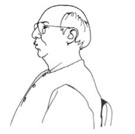
When should you do pursed-lip breathing?
Use pursed-lipped breathing during and after exercise, and any time you feel short of breath.
Conserve energy with coordinated breathing
You may feel short of breath during many common activities and daily tasks. Practicing a few simple coordinated breathing techniques can help you live and work with less breathlessness.
Try coordinated breathing to conserve energy during these activities:
Bending:
Bending puts pressure on your diaphragm. This may make you feel more short of breath. When you bend:
- Keep your back straight
- Exhale as you lower yourself with your legs

Stooping and reaching:
Exhale as you lean forward.
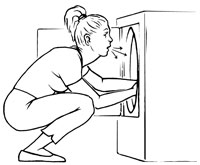
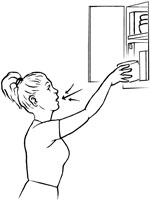
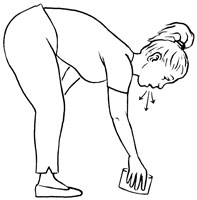
As you straighten up, inhale.

Lifting:
- Exhale on exertion and as you lift.
- Avoid holding your breath.
- Divide the load into smaller portions.
- Use your leg muscles to avoid straining your back.

Pushing and pulling:
Coordinate your breathing with your movements. For example, when vacuuming, exhale as you push, then inhale as you pull.
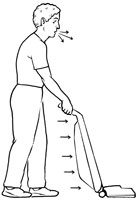
Other strategies to help you conserve energy
Carrying
Avoid carrying things next to your chest.
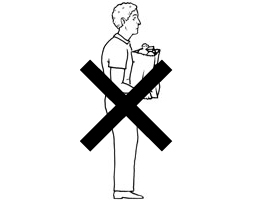
Carry one bag in each hand. Or use over-the-shoulder grocery bags, so your shoulders absorb the weight.
![]()
Use a backpack, if you don’t have back problems.

You may also want to consider using a cart or a luggage carrier.
Crouching:
Crouching restricts the movement of your diaphragm. Your legs push against your chest, making it harder to breathe. Avoid crouching, if you can.
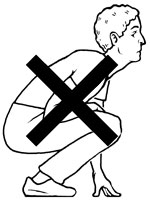
It’s better to sit down, or get down on your hands and knees if you have to do a task for a long time.
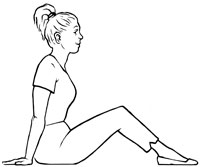
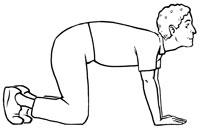
Climbing stairs:
Stair climbing is a demanding activity that may cause shortness of breath. Pace yourself, and rest every few steps (or at every step) if you need to.
- Exhale when you take a step up
- Inhale when you rest
- Try to breathe evenly and smoothly.
- Find a pattern that is comfortable for you.
Follow an even rhythm of leaning and standing, and match your breath to this rhythm.
You may also want to think about using a long-handled “reacher” for tasks that involve bending, stooping, and crouching. You can find them in pharmacies and medical supply stores. They’re a great way to save energy while doing household chores.
Using your arms and hands vigorously:
- Stabilize yourself against a wall, or sit in a chair with a back you can lean against.
- Support your elbows on the table or desk edge while using your arms.
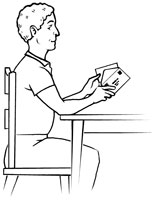
Taking these steps allows you to relax your breathing muscles while using your arms.
Tips for recovery
Leaning forward helps you breathe by placing your diaphragm on a diagonal stretch between your ribs and spine. This gives it a bit more elasticity for breathing and can help you recover when you’ve lost your breath.
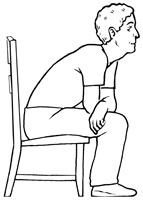
Recovery breathing can help you get your breathing back to normal if you’re panting or out of breath.
S.O.S FOR S.O.B. (Shortness of Breath)
- Stop and rest in a comfortable position
- Get your head down
- Get your shoulders down
- Breathe in through your mouth
- Blow out through your mouth
- Breathe in and blow out as fast as is necessary
- Begin to blow out longer but not forcibly while slowing your breathing
- Begin to breathe deeply in and out through your nose
- Stay in the position for 5 minutes or longer
For more in-depth information on this topic, please visit the Big Fat Reference Guide (BFRG). If you are enrolled in AlphaNet’s Subscriber Portal, you can access the BFRG here.
Download How to Conserve Energy During Daily Life as a PDF.


